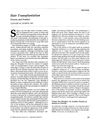Hair Transplantation Update
January 1998
in “
Journal of Cutaneous Medicine and Surgery
”
hair transplantation micrografting minigrafting tumescent anesthesia slit grafting strip harvesting megasessions isolated frontal forelock laser hair transplantation male-pattern baldness female alopecia hair transplant micrografts minigrafts tumescent anesthesia slit grafts strip harvesting megasessions frontal forelock laser hair transplant male-pattern baldness female hair loss

TLDR Hair transplantation is effective for baldness, with new methods improving results, but staying updated is crucial for patient outcomes.
The 1998 article reviewed the state of hair transplantation, noting significant advancements such as micrografting and minigrafting, which improved the natural appearance of transplanted hair. Tumescent anesthesia was recognized for reducing pain, but with potential complications. The shift from round grafts to micrografts and minigrafts, as well as slit grafting, were discussed for their benefits and drawbacks. Strip harvesting was highlighted for minimizing scarring and maximizing donor tissue use. The paper was cautious about megasessions and discussed the conservative "isolated frontal forelock" approach. Laser hair transplantation was mentioned, with its benefits and disadvantages. The authors concluded that hair transplantation is an effective treatment for male-pattern baldness and female alopecia, with recent techniques enhancing results, but they stressed the importance of staying current with the latest developments to ensure the best outcomes for patients.



